R-20 Album: Difference between revisions
(Created page with "Category:The Men File:Header 4 New.jpg File:Red bar sub new.jpg === <big>USS R-20 Photo Album</big> === <div style="text-align: justify;"><span style="color:#00008B"> This photo album was found in the archives of the Vallejo Naval & Historical Museum by Mr. Darryl Baker who has spent many hours copying these images to share. The album is from an unnamed sailor who apparently served aboard the USS R-20 in its very early years in service with the United States...") |
No edit summary |
||
| Line 18: | Line 18: | ||
These early R-Class submarines were built with the retractable 3"/23 caliber deck guns. The gun in this photo is in the raised position. Normally the gun would be retracted into it waterproof housing to protect it from sea water. | These early R-Class submarines were built with the retractable 3"/23 caliber deck guns. The gun in this photo is in the raised position. Normally the gun would be retracted into it waterproof housing to protect it from sea water. | ||
[[File:Red Star Line.jpg]] | |||
[[File:R-20-02.jpg ||left|thumb|300px|<center>Vallejo Naval & Historical Museum via Mr Darryl Baker</center>]] | [[File:R-20-02.jpg ||left|thumb|300px|<center>Vallejo Naval & Historical Museum via Mr Darryl Baker</center>]] | ||
[[File:Red | This next photo in the sequence shows the wave covering the deck and putting the gun underwater. It was unusual to leave this particular gun in the raised position while proceeding on the surface at speed and in these kind of seas. | ||
One of the major reasons to make the gun retractable was to protect it from seawater induced corrosion, reducing maintenance requirements. With the waves inundating it in this fashion, the gun would have required careful and intensive maintenance once the boat returned to port. | |||
Other submarines, most likely squadron mates, can be seen directly ahead and off the port bow. It is possible that the boats were proceeding to a gunnery training area when these photos were taken. | |||
[[File:Red Star Line.jpg]] | |||
[[File:R-20-03.jpg ||left|thumb|300px|<center>Vallejo Naval & Historical Museum via Mr Darryl Baker</center>]] | [[File:R-20-03.jpg ||left|thumb|300px|<center>Vallejo Naval & Historical Museum via Mr Darryl Baker</center>]] | ||
[[File:Red | The R-20 continues to pound through the swells, temporarily submerging the entire forward deck all the way up to the gun, whose circular shield can just be seen. | ||
[[File:Red Star Line.jpg]] | |||
[[File:R-20-04.jpg ||left|thumb|300px|<center>Vallejo Naval & Historical Museum via Mr Darryl Baker</center>]] | [[File:R-20-04.jpg ||left|thumb|300px|<center>Vallejo Naval & Historical Museum via Mr Darryl Baker</center>]] | ||
The R-20 continues driving through the ocean swells off the Southern California Coast. Probably for some Torpedo and maybe Gunnery practice. | |||
[[File:Red Star Line.jpg]] | |||
[[File:R-20-05.jpg ||left|thumb|300px|<center>Vallejo Naval & Historical Museum via Mr Darryl Baker</center>]] | |||
The R-20 continues driving through the ocean swells off the Southern California Coast. Probably for some Torpedo and maybe Gunnery practice. | |||
[[File:Red bar sub new.jpg]] | [[File:Red bar sub new.jpg]] | ||
=== <big>Running On The Surface ~ Deck Gun Housed</big> === | |||
[[File:R-20-06.jpg ||left|thumb|300px|<center>Vallejo Naval & Historical Museum via Mr Darryl Baker</center>]] | [[File:R-20-06.jpg ||left|thumb|300px|<center>Vallejo Naval & Historical Museum via Mr Darryl Baker</center>]] | ||
[[File:Red | It is not known if this and the next photo were taken at the same time as the photos above. In this photo the gun has been retracted into a watertight tub that penetrated the pressure hull down into the forward battery room. The circular gun shield forms a watertight “hatch” that protected the gun breech and the elevation and training mechanisms. A tampion is inserted into the muzzle end to protect the rifled bore from corrosion. | ||
Out of sight in this photo is the recoil dampening cylinder, which also penetrated the gun shield. It is behind the barrel. Lifelines and stanchions have been put in place on the edges of the deck to give the gun crew some level of protection from falling over the side. | |||
[[File:Red Star Line.jpg]] | |||
[[File:R-20-07.jpg ||left|thumb|300px|<center>Vallejo Naval & Historical Museum via Mr Darryl Baker</center>]] | [[File:R-20-07.jpg ||left|thumb|300px|<center>Vallejo Naval & Historical Museum via Mr Darryl Baker</center>]] | ||
Another angle looking almost directly forward on the deck with a good look at the gun barrel. The two tubes or pipes on the deck are the torpedo loading mast and boom in their stowed positions. Later, when the larger deck gun will replace this one, these will be stored on the after deck leaving more room to train and point the large weapon. | |||
The large rectangular deck hatch is the opening into the superstructure giving access to the slanted Torpedo Loading Hatch below it. It has a dual purpose. 1 to act as a deck cover for the opening and 2 to act as a slanted loading ramp for the torpedo to rest and slide on. Its hinges are on the after end of the hatch and it folds up and back making the ramp. | |||
[[File:Red bar sub new.jpg]] | [[File:Red bar sub new.jpg]] | ||
=== <big>Firing Torpedo</big> === | |||
[[File:R-20-08.jpg ||left|thumb|300px|<center>Vallejo Naval & Historical Museum via Mr Darryl Baker</center>]] | [[File:R-20-08.jpg ||left|thumb|300px|<center>Vallejo Naval & Historical Museum via Mr Darryl Baker</center>]] | ||
[[File:Red | The R-20 fires a practice torpedo from either her #1 or #3 torpedo tube. As it exits the tube, after approximately 100 or so feet, it broaches the surface before diving back to its set running depth. | ||
The puff of "smoke" is actually steam, as the Mk 9 and Mk 10 Bliss-Levitt torpedoes used by the R-boats had a wet-heater type engine. This engine used an alcohol fueled flame to heat water into steam, which then spun the turbine to turn a dual contra-rotating propeller. | |||
The weapon left a trail of combustion gases and steam in its wake, creating the characteristic white trail behind it. If the weapon broached it would leave a puff of steam in the air. Broaching was neither intended or desired, as it gave warning to the target of the approaching torpedo. | |||
These torpedoes had notoriously finicky depth keeping mechanisms, sometimes following a "sine wave" style up and down course to the target, with obvious negative implications to accuracy. | |||
[[File:Red Star Line.jpg]] | |||
[[File:R-20-09.jpg ||left|thumb|300px|<center>Vallejo Naval & Historical Museum via Mr Darryl Baker</center>]] | [[File:R-20-09.jpg ||left|thumb|300px|<center>Vallejo Naval & Historical Museum via Mr Darryl Baker</center>]] | ||
As the R-20 continues running on her assigned course, following the fired torpedo, its track of exhaust bubbles spreads out behind it. The next job for the R-20 will be to locate the torpedo and hoist it back aboard. It is then carefully lowered down into the torpedo room to be returned to the Naval Station for overhaul by the torpedo shop, and will be eventually reused. | |||
The large wing-like array on the bow is the Y-tube sonar. It consists of three hydrophones covered by a flexible streamlined rubber "rat" that smooths the flow of water over the hydrophone, reducing ambient noise. The hydrophone wings are attached to a prominent U-shaped bracket that raised them above the deck, allowing a towing hawser to pass underneath. | |||
[[File:Red Star Line.jpg]] | |||
[[File:R-20-10.jpg ||left|thumb|300px|<center>Vallejo Naval & Historical Museum via Mr Darryl Baker</center>]] | |||
The track of exhaust bubbles thins out behind the fired torpedo as the R-20 still follows. | |||
[[File:Red bar sub new.jpg]] | [[File:Red bar sub new.jpg]] | ||
=== <big>Retrieving Torpedo </big> === | |||
[[File:R-20-11.jpg ||left|thumb|300px|<center>Vallejo Naval & Historical Museum via Mr Darryl Baker</center>]] | [[File:R-20-11.jpg ||left|thumb|300px|<center>Vallejo Naval & Historical Museum via Mr Darryl Baker</center>]] | ||
[[File:Red | At the time frame this photo was taken it was not unusual for submarines during torpedo training exercises to locate and retrieve their fired practice torpedo. That is what it looks like is happening here. The torpedo fired in the above sequence has now been picked up and hoisted onto deck and is being loaded back down into the submarine. | ||
Once back in port the torpedo will be pulled out of the submarine in a reverse of the procedure seen here. | |||
With his back to the camera is most likely a Torpedoman Chief Petty officer but in this case and time frame it is likely this is a Chief Gunnersmate with a Torpedo rating. | |||
On the right other man looks to be an officer supervising the process. | |||
[[File:Red Star Line.jpg]] | |||
[[File:R-20-12.jpg ||left|thumb|300px|<center>Vallejo Naval & Historical Museum via Mr Darryl Baker</center>]] | [[File:R-20-12.jpg ||left|thumb|300px|<center>Vallejo Naval & Historical Museum via Mr Darryl Baker</center>]] | ||
[[File:Red | |||
[[File:Red Star Line.jpg]] | |||
[[File:R-20-13.jpg ||left|thumb|300px|<center>Vallejo Naval & Historical Museum via Mr Darryl Baker</center>]] | [[File:R-20-13.jpg ||left|thumb|300px|<center>Vallejo Naval & Historical Museum via Mr Darryl Baker</center>]] | ||
[[File:Red bar sub new.jpg]] | [[File:Red bar sub new.jpg]] | ||
=== <big>Crew </big> === | |||
[[File:R-20-14.jpg ||left|thumb|300px|<center>Vallejo Naval & Historical Museum via Mr Darryl Baker</center>]] | [[File:R-20-14.jpg ||left|thumb|300px|<center>Vallejo Naval & Historical Museum via Mr Darryl Baker</center>]] | ||
[[File:Red bar sub new.jpg]] | [[File:Red bar sub new.jpg]] | ||
Revision as of 14:47, 18 May 2023
USS R-20 Photo Album
This photo album was found in the archives of the Vallejo Naval & Historical Museum by Mr. Darryl Baker who has spent many hours copying these images to share. The album is from an unnamed sailor who apparently served aboard the USS R-20 in its very early years in service with the United States Navy. His small and imperfect camera has preserved remarkable images rarely seen in much bigger archives. The camera produced images of only 2.5 inches by 1.75 inches in size so the quality is not of the best but the images preserved are of the utmost importance.
Especially important are the photos showing the modifications to the hulls necessary for the transition from the 3 inch 23 caliber deck gun that these submarines were first outfitted with and the and preparations necessary for the installation of the much larger 4 inch 50 caliber gun. This necessitated the enlargement of the deck area with sponsons to accommodate the larger swinging area for this gun.
The photos were taken over a span of time. In some of the images the three vertical stripes on the chariot bridge are missing and in others they are present. The assumption is the lack of stripes are the earlier photos and the presence of them are later. No intention was made to sequence the photos by this time frame. They have been grouped by subject matter thereby creating a narrative on the page that is less scattered and more cohesive. It is clear now that the shapes painted on the bridge structures were done early in these submarines' lives and they wore them for a good majority of their service.
Running On The Surface ~ Deck Gun Raised
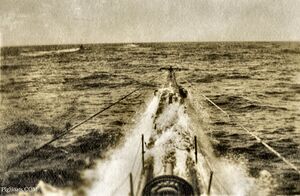
The USS R-20 heading out to sea on exercises with sister ships seen in the advance. The bow is dipping into the waves and washing over on to the deck.
These early R-Class submarines were built with the retractable 3"/23 caliber deck guns. The gun in this photo is in the raised position. Normally the gun would be retracted into it waterproof housing to protect it from sea water.
![]()
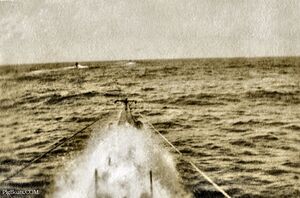
This next photo in the sequence shows the wave covering the deck and putting the gun underwater. It was unusual to leave this particular gun in the raised position while proceeding on the surface at speed and in these kind of seas.
One of the major reasons to make the gun retractable was to protect it from seawater induced corrosion, reducing maintenance requirements. With the waves inundating it in this fashion, the gun would have required careful and intensive maintenance once the boat returned to port.
Other submarines, most likely squadron mates, can be seen directly ahead and off the port bow. It is possible that the boats were proceeding to a gunnery training area when these photos were taken.
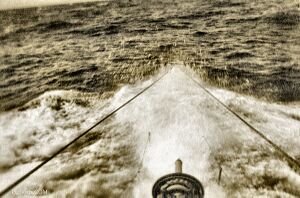
The R-20 continues to pound through the swells, temporarily submerging the entire forward deck all the way up to the gun, whose circular shield can just be seen.
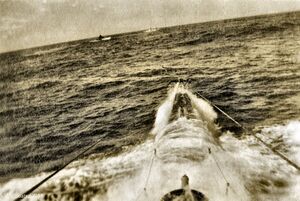
The R-20 continues driving through the ocean swells off the Southern California Coast. Probably for some Torpedo and maybe Gunnery practice.
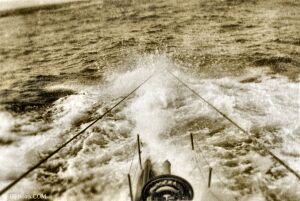
The R-20 continues driving through the ocean swells off the Southern California Coast. Probably for some Torpedo and maybe Gunnery practice.
Running On The Surface ~ Deck Gun Housed
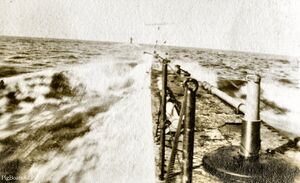
It is not known if this and the next photo were taken at the same time as the photos above. In this photo the gun has been retracted into a watertight tub that penetrated the pressure hull down into the forward battery room. The circular gun shield forms a watertight “hatch” that protected the gun breech and the elevation and training mechanisms. A tampion is inserted into the muzzle end to protect the rifled bore from corrosion.
Out of sight in this photo is the recoil dampening cylinder, which also penetrated the gun shield. It is behind the barrel. Lifelines and stanchions have been put in place on the edges of the deck to give the gun crew some level of protection from falling over the side.
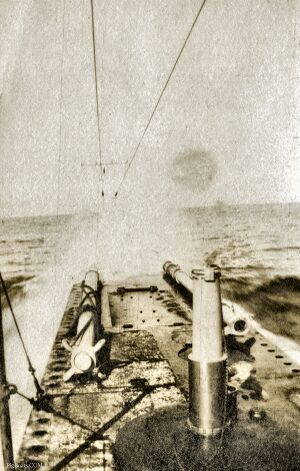
Another angle looking almost directly forward on the deck with a good look at the gun barrel. The two tubes or pipes on the deck are the torpedo loading mast and boom in their stowed positions. Later, when the larger deck gun will replace this one, these will be stored on the after deck leaving more room to train and point the large weapon.
The large rectangular deck hatch is the opening into the superstructure giving access to the slanted Torpedo Loading Hatch below it. It has a dual purpose. 1 to act as a deck cover for the opening and 2 to act as a slanted loading ramp for the torpedo to rest and slide on. Its hinges are on the after end of the hatch and it folds up and back making the ramp.
Firing Torpedo
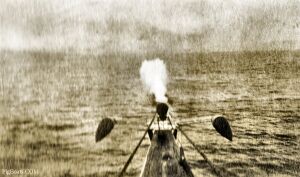
The R-20 fires a practice torpedo from either her #1 or #3 torpedo tube. As it exits the tube, after approximately 100 or so feet, it broaches the surface before diving back to its set running depth.
The puff of "smoke" is actually steam, as the Mk 9 and Mk 10 Bliss-Levitt torpedoes used by the R-boats had a wet-heater type engine. This engine used an alcohol fueled flame to heat water into steam, which then spun the turbine to turn a dual contra-rotating propeller.
The weapon left a trail of combustion gases and steam in its wake, creating the characteristic white trail behind it. If the weapon broached it would leave a puff of steam in the air. Broaching was neither intended or desired, as it gave warning to the target of the approaching torpedo.
These torpedoes had notoriously finicky depth keeping mechanisms, sometimes following a "sine wave" style up and down course to the target, with obvious negative implications to accuracy.
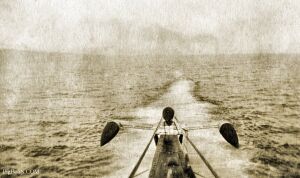
As the R-20 continues running on her assigned course, following the fired torpedo, its track of exhaust bubbles spreads out behind it. The next job for the R-20 will be to locate the torpedo and hoist it back aboard. It is then carefully lowered down into the torpedo room to be returned to the Naval Station for overhaul by the torpedo shop, and will be eventually reused.
The large wing-like array on the bow is the Y-tube sonar. It consists of three hydrophones covered by a flexible streamlined rubber "rat" that smooths the flow of water over the hydrophone, reducing ambient noise. The hydrophone wings are attached to a prominent U-shaped bracket that raised them above the deck, allowing a towing hawser to pass underneath.
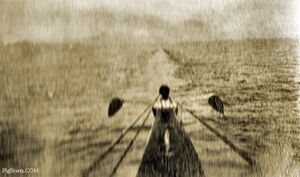
The track of exhaust bubbles thins out behind the fired torpedo as the R-20 still follows.
Retrieving Torpedo
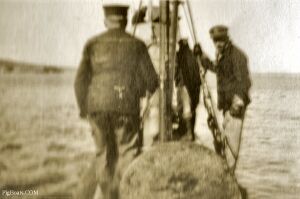
At the time frame this photo was taken it was not unusual for submarines during torpedo training exercises to locate and retrieve their fired practice torpedo. That is what it looks like is happening here. The torpedo fired in the above sequence has now been picked up and hoisted onto deck and is being loaded back down into the submarine.
Once back in port the torpedo will be pulled out of the submarine in a reverse of the procedure seen here.
With his back to the camera is most likely a Torpedoman Chief Petty officer but in this case and time frame it is likely this is a Chief Gunnersmate with a Torpedo rating.
On the right other man looks to be an officer supervising the process.
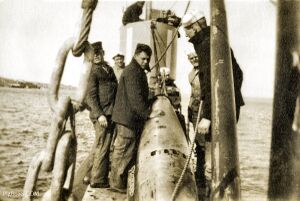
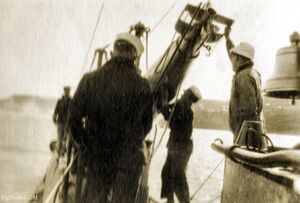
Crew
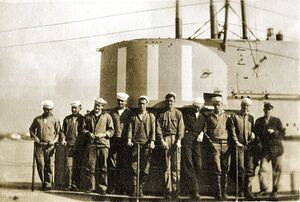
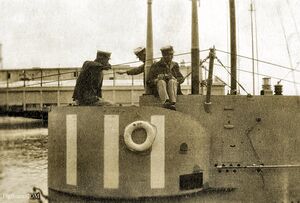
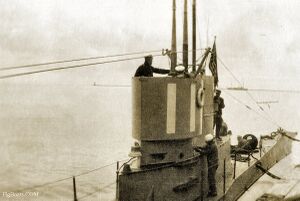
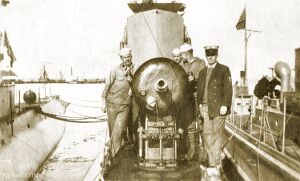
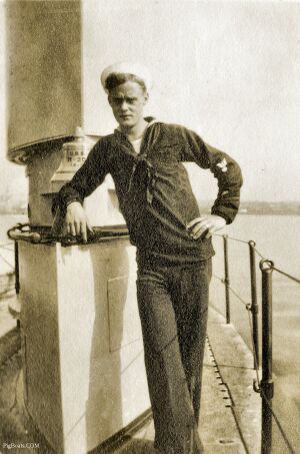
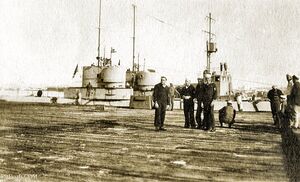

Page created by:
Ric Hedman & David Johnston
1999 - 2023 - PigBoats.COM©
Mountlake Terrace, WA, Norfolk, VA
webmaster at pigboats dot com
